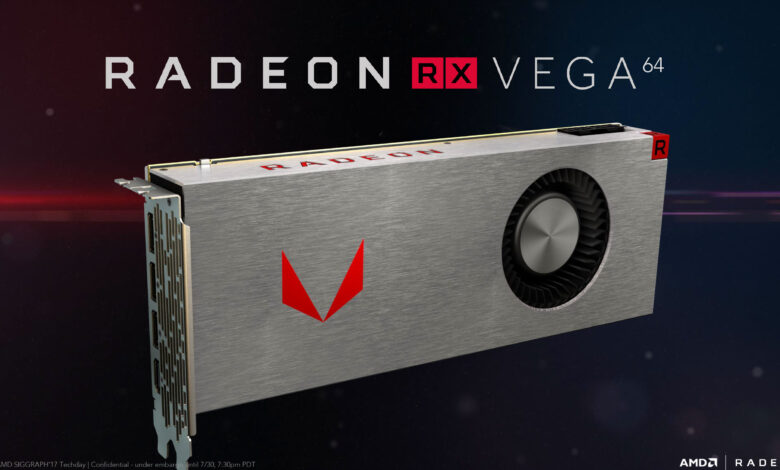AMD Vega: Revolutionizing Graphics Performance with High-Bandwidth Memory and Powerful Architecture 2024

Introduction to AMD Vega
Overview
AMD Vega series represents a significant milestone in graphics processing technology, specifically focusing on delivering high-end performance for gamers, creatives, and tech enthusiasts. Launched by AMD, the Vega architecture aimed to bridge the gap between everyday graphics and professional-grade rendering capabilities. Built upon cutting-edge technologies like HBM2 (High Bandwidth Memory) and featuring a robust architecture, AMD Vega continues to be a formidable choice even in today’s fast-paced graphics environment.
Importance of AMD Vega in the GPU Market
AMD Vega’s launch was a response to the demand for more powerful, versatile, and efficient GPUs. Competing with NVIDIA’s prominent offerings, AMD Vega allowed AMD to stand out in terms of innovation and affordability. The unique combination of advanced architecture, high memory bandwidth, and power efficiency set apart from the crowd, appealing to both budget-conscious gamers and professional content creators who demand more from their GPUs.
Development History of AMD Vega
The AMD Vega series was developed with ambitious goals—AMD wanted to redefine GPU architecture. Named after the brightest star in the Lyra constellation, Vega represented AMD’s hope to lead the industry toward new heights of performance. This journey saw AMD investing heavily in the research and development of high-bandwidth memory, power-efficient designs, and advanced GPU acceleration technology.
Key Features of AMD Vega Architecture

HBM2 Memory: A Game Changer
One of the most defining features of is its use of HBM2 memory, which was relatively new in the consumer GPU market at the time of Vega’s release. HBM2 allowed for faster data transfer rates between the memory and the GPU, ultimately enhancing performance and reducing power consumption.
Compute Units and Enhanced Shaders
AMD Vega’s architecture integrates numerous compute units, which form the foundation of its raw processing power. These units are designed for both parallel processing and improved rendering capabilities, making suitable for multitasking-intensive applications. Enhanced shaders add to Vega’s ability to handle high-quality graphics without compromising on speed.
Optimized Cache Hierarchy
The cache system within AMD Vega is optimized to reduce latency and improve data access speeds. This efficient cache hierarchy minimizes bottlenecks in data flow, allowing to handle intensive graphical tasks more efficiently. This improvement is crucial for applications that demand high processing power, such as VR environments and AI applications.
How AMD Vega Differs from Previous GPUs
Comparison with Polaris Architecture
The Polaris architecture, Vega’s predecessor, was well-regarded for its balance of performance and affordability. However, AMD Vega took this a step further, introducing significant advancements in speed, efficiency, and memory usage. Unlike Polaris, which was limited to GDDR5 memory, HBM2 technology gave it an undeniable advantage in terms of bandwidth.
Notable Improvements and Technological Advancements
With Vega, AMD introduced various innovative technologies, including support for asynchronous computing and real-time ray tracing. These technologies made Vega not only faster than previous AMD GPUs but also more compatible with future gaming and professional software. Vega’s architectural advancements also meant better overall power efficiency, a crucial aspect for users who want high performance without excessive energy costs.
Vega’s High Bandwidth Memory (HBM2)
Advantages of HBM2 in AMD Vega
HBM2, or High Bandwidth Memory, is a revolutionary type of memory that is stacked vertically on the GPU die, reducing physical space while dramatically increasing data throughput. For, HBM2 enabled the graphics cards to achieve higher performance levels without the increased power consumption typically associated with traditional GDDR5 memory.
Enhanced Power Efficiency and Reduced Heat
With HBM2’s compact design, GPUs require less power to operate, even under high loads. This efficiency results in reduced heat generation, which contributes to longer-lasting hardware and a more stable gaming or creative production environment. This feature makes AMD Vega a preferred choice for users who demand performance but are also concerned about energy costs.
AMD Vega Graphics Cards Lineup
RX Vega 56: A Balanced Performer
The RX Vega 56 is one of the more accessible options in the lineup, offering a solid balance between price and performance. Equipped with HBM2 memory and numerous compute units, the RX Vega 56 performs well in both gaming and productivity tasks, making it ideal for users who want a versatile GPU without breaking the bank.
RX Vega 64: High-End Gaming Experience
The RX Vega 64 is a step up from the Vega 56, designed for more serious gamers and professionals. With additional compute units and a higher memory clock speed, the RX Vega 64 can handle graphically intensive applications like 4K gaming and VR. Its performance is on par with some of NVIDIA’s higher-end GPUs, yet it comes at a relatively affordable price point.
Vega Frontier Edition: Professional-Level Graphics
The Vega Frontier Edition was tailored for professional users, especially those involved in fields like 3D modeling, machine learning, and scientific visualization. Boasting higher specifications than the RX Vega 64, this card includes optimizations for content creation and accelerated productivity, bridging the gap between consumer and workstation GPUs.
Performance Analysis of AMD Vega GPUs

Gaming Benchmarks and Real-world Testing
In gaming, GPUs excel in both 1080p and 1440p resolutions, delivering consistently high frame rates across a range of games. Benchmarks indicate that the RX Vega 64 competes closely with NVIDIA’s GTX 1080, particularly in games optimized for AMD hardware.
VR and High-Fidelity Gaming
AMD Vega’s performance in VR is notable, as the architecture is designed to handle complex environments with minimal latency. This capability makes ideal for high-fidelity gaming, where frame rates, smooth transitions, and visual quality are paramount.
Productivity Tasks and General Performance
For content creators and professionals, GPUs bring reliable performance to applications such as video editing, 3D rendering, and CAD design. The high memory bandwidth of HBM2 allows for smoother workflows and faster rendering times, crucial for users working with large files or complex projects.
Gaming Experience with AMD Vega
Real-time Performance for Gamers
AMD Vega GPUs cater to gamers who want fluid gameplay without sacrificing visual quality. With features like async compute and HBM2, AMD Vega GPUs handle real-time processing tasks, such as shadow rendering and dynamic lighting, more effectively than many other GPUs in the same price range.
FPS Benchmarks and Competitive Edge
When tested in popular games like Shadow of the Tomb Raider, Fortnite, and Overwatch, GPUs demonstrate a competitive frame rate. The RX Vega 64, for example, can maintain around 100 FPS in Overwatch at high settings, which provides an edge in fast-paced, competitive games.
Optimal Gaming Settings for AMD Vega
For most games, performs best at 1440p resolution with medium-to-high settings, balancing graphical quality with frame rate. Users looking to push further can often achieve a stable 4K experience by adjusting anti-aliasing and shadow quality settings, which helps maintain smooth performance without a drastic drop in visuals.
Productivity with AMD Vega: Beyond Gaming
Accelerated Video Editing
AMD Vega’s architecture is especially advantageous for video editors, as HBM2 memory speeds up the rendering of high-resolution video files. support for OpenCL also enhances compatibility with editing software, making it a preferred choice for creators.
Machine Learning Capabilities
With the growing demand for machine learning, provides support for AI tasks, such as training and inference. Vega’s parallel processing power, combined with its high memory bandwidth, allows it to handle machine learning workloads more effectively than other consumer GPUs.
Content Creation and 3D Modeling
Content creators and 3D artists will appreciate the increased performance Vega brings to software like Blender, AutoCAD, and Maya. The GPU’s compute units are optimized to process 3D renderings, speeding up production times and making a valuable tool for creative professionals.
AMD Vega and VR: Enhancing Immersive Experiences
Performance for VR Applications
Virtual reality demands low-latency, high-frame-rate performance, which AMD Vega handles well due to its advanced architecture. The combination of HBM2 memory and optimized shaders allows to manage VR environments smoothly, reducing the likelihood of motion sickness and enhancing the immersive experience.
Latency Reduction and Enhanced Immersion
AMD Vega’s efficient latency management is essential for VR. By reducing input lag and increasing frame rates, ensures that users have a more responsive and engaging VR experience, making it a preferred choice for VR gamers and developers.
VR-Specific Features of AMD Vega
With support for VR standards like LiquidVR, AMD Vega is compatible with leading VR headsets, allowing users to enjoy a wide range of VR content. ability to render complex environments without performance loss enhances VR realism, which is crucial for both gaming and professional applications.
AMD Vega for Content Creators
Faster Rendering Speeds
Rendering is a resource-intensive task, but HBM2 memory and efficient architecture make it faster and more manageable. Whether rendering a complex animation or processing a high-resolution video, AMD Vega provides the speed and consistency that content creators need.
Graphic Design and Photo Editing
Graphic designers benefit from enhanced color accuracy and sharpness. For photo editing and digital art, offers detailed rendering, accurate color reproduction, and faster performance with applications like Adobe Photoshop and Lightroom.
Video Editing and Special Effects
AMD Vega’s ability to handle large data files and multiple layers of video is invaluable for editors and special effects artists. With real-time playback in editing software and accelerated exporting, makes video production more efficient and enjoyable.
Energy Efficiency in AMD Vega
Managing Power Consumption
AMD Vega GPUs are built to balance performance with power consumption. HBM2 memory requires less power, which significantly reduces overall power usage without sacrificing performance, making a strong choice for users who want performance without excessive energy costs.
Effective Heat Management
In high-performance environments, heat can affect GPU performance, but AMD Vega’s design includes advanced thermal solutions to manage heat effectively. This makes a cooler, quieter option, even when under heavy loads, and reduces the need for additional cooling setups.
AMD Vega vs. NVIDIA: A Comparison
Performance and Benchmark Analysis
Comparing AMD Vega with NVIDIA’s competing GPUs, stands out in multitasking and memory bandwidth due to its HBM2 technology. However, NVIDIA GPUs tend to have an edge in raw processing power in certain gaming scenarios, making each brand appealing to different types of users.
Cost and Affordability
AMD Vega’s pricing is generally competitive, making it an attractive option for users seeking high-end performance on a budget. NVIDIA’s offerings, on the other hand, can be pricier for comparable performance levels, which is a consideration for cost-conscious buyers.
Software and Driver Support
While both AMD and NVIDIA provide extensive software support, AMD’s drivers have historically been optimized for a broader range of applications, giving users additional flexibility in software compatibility, especially for productivity tasks.
Future of AMD Vega: Impact and Legacy
Technological Influence on Next-Generation GPUs
AMD Vega’s introduction of HBM2 and other innovative features has influenced GPU development across the industry. Future GPUs are expected to build on Vega’s architecture, with improvements in speed, efficiency, and power consumption.
Evolving Standards and Compatibility
As AMD continues to evolve its lineup, AMD Vega remains compatible with many new standards and technologies. This longevity ensures that will retain its relevance in the tech world, even as newer GPUs enter the market.
Upgrading to AMD Vega: Is It Worth It?
Considerations for Potential Upgraders
Upgrading to is a worthwhile investment for users who need better gaming performance, faster rendering speeds, or improved multitasking capabilities. However, users with existing high-performance GPUs may want to consider the Vega series only if they need specific features like HBM2 memory.
Who Should Upgrade to AMD Vega?
AMD Vega is ideal for gamers, content creators, and professionals who need a versatile and high-performance GPU. However, casual users may not notice a significant difference in everyday tasks, so upgrading should be based on individual needs.
Common Issues and Troubleshooting for AMD Vega
Overheating and Cooling Solutions
One of the common issues with GPUs is overheating during prolonged use. Ensuring adequate airflow, using high-quality thermal paste, and regularly cleaning the GPU can help mitigate this problem.
Driver and Software Compatibility Issues
Some users have reported driver issues with, though AMD has continually released updates to improve compatibility. Ensuring that the latest drivers are installed can often resolve these issues and enhance performance.
Tips for Maximizing Performance
To get the most out of an GPU, users can enable features like Radeon Chill for power efficiency, adjust fan settings for better cooling, and tweak graphical settings to achieve a balance between visual quality and performance.
Frequently Asked Questions about AMD Vega
Is AMD Vega still a good option in 2024?
Yes, remains a solid choice, especially for users who need high bandwidth memory and are on a budget.
Can AMD Vega handle 4K gaming?
While it can handle 4K, performs best at 1440p resolution, where it can maintain higher frame rates.
How does AMD Vega compare with newer AMD GPUs?
Newer AMD GPUs, such as those based on RDNA architectures, may offer improved performance but lack some of Vega’s HBM2 advantages.
What makes AMD Vega ideal for content creators?
The HBM2 memory in is optimized for fast data processing, making it ideal for rendering, video editing, and 3D modeling tasks.
How can I optimize my AMD Vega GPU for gaming?
Adjusting settings in Radeon Software, using Radeon Chill, and keeping drivers updated can help optimize performance.
Does AMD Vega support ray tracing?
does not have dedicated ray-tracing cores, but it can handle some real-time lighting effects through software-based techniques.
Conclusion
AMD Vega has proven to be a transformative GPU architecture, offering high performance, innovative memory solutions, and energy efficiency. Whether for gaming, content creation, or VR, stands as a testament to AMD’s commitment to delivering quality graphics solutions. Its legacy endures as a reliable choice for both casual and professional users.



